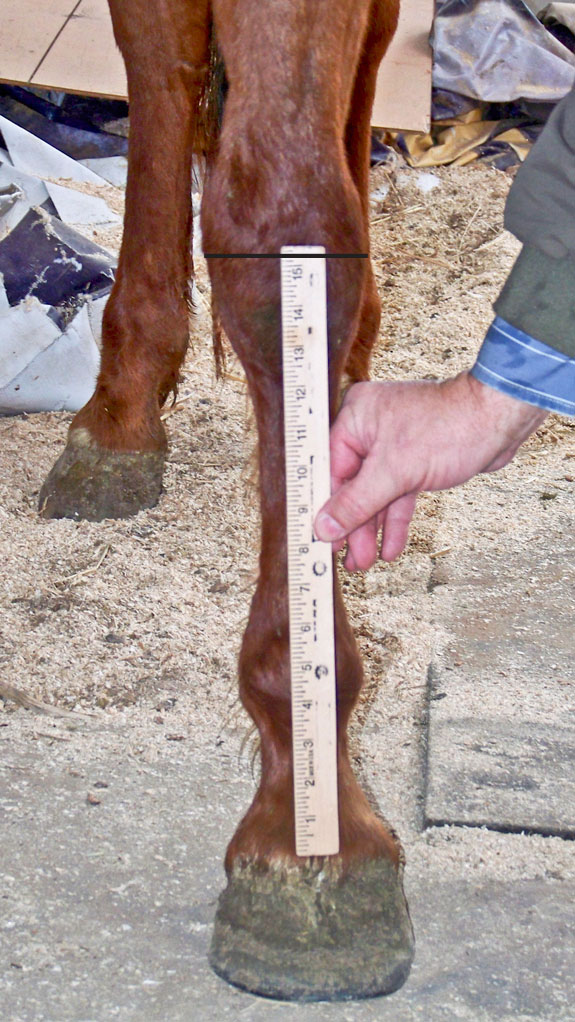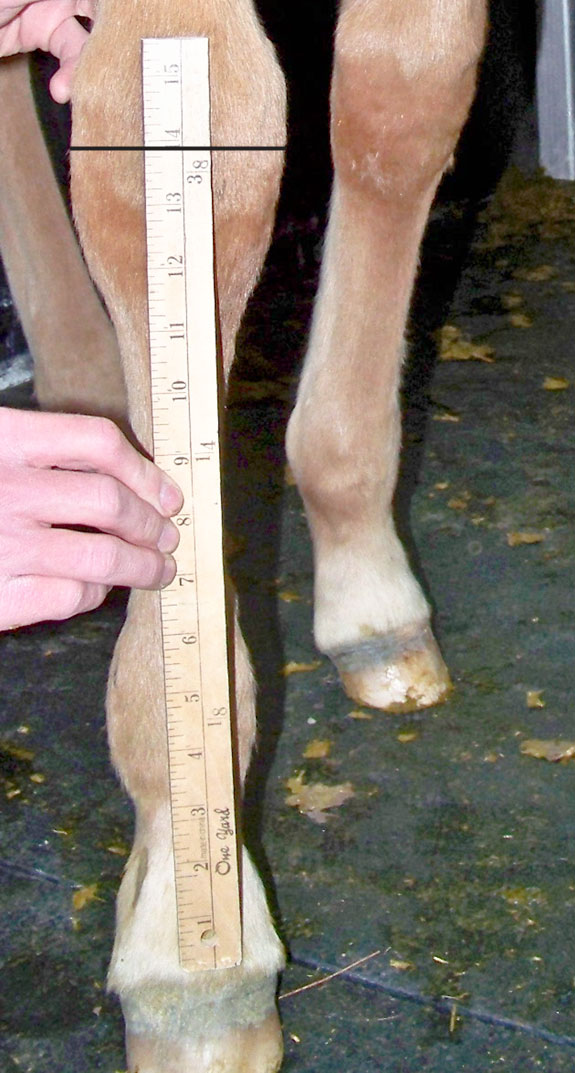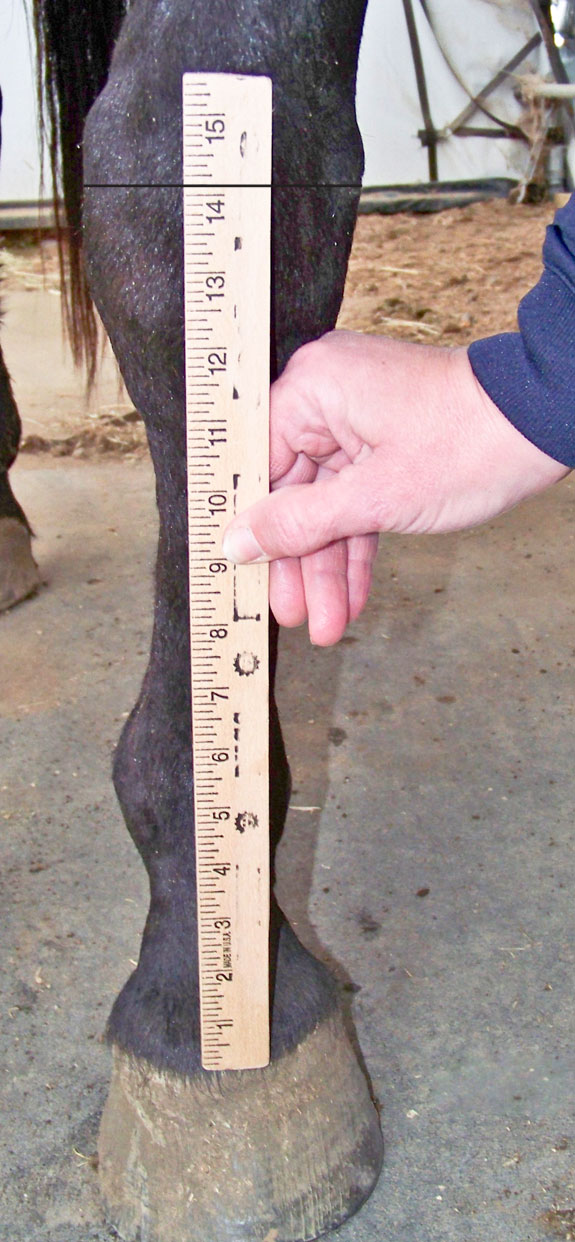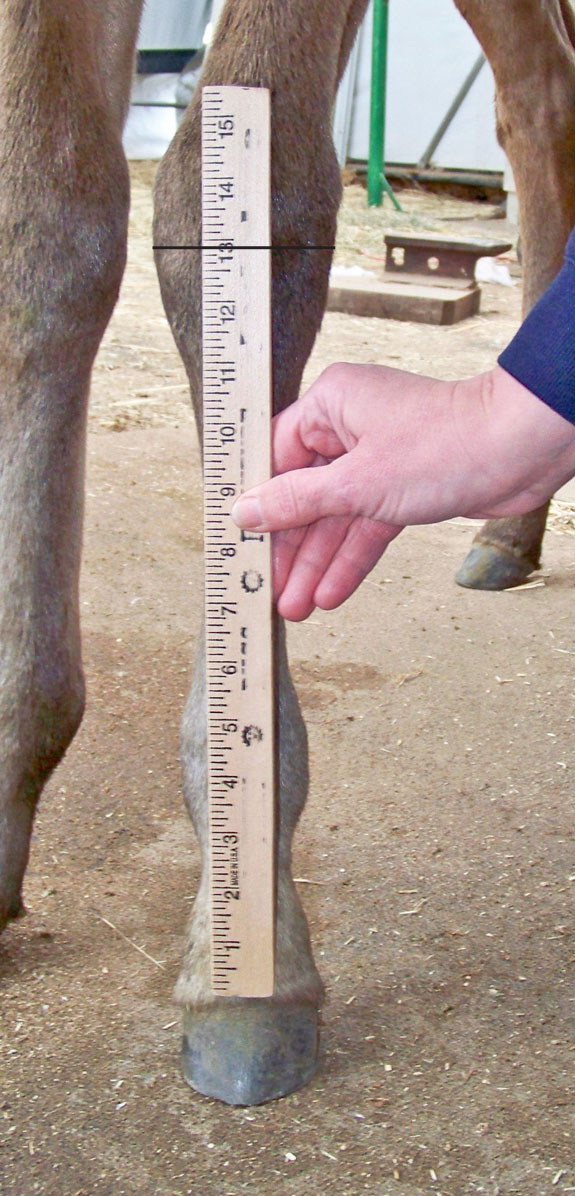The method of measurement shown me was one taken on a straight line from the front of either front leg starting at the corona or hairline and extending to the middle of the knee joint.

This gives a measurement in inches that would convert directly to hands on the adult animal.
I was also told that this measurement would be true from 3 months old upward and would always be accurate throughout the lifetime of the horse.
Example: a foal measuring 15 ¼ inches translated to a mature horse measuring 15.1hh, (61” tall at the highest point on the withers).
This handy measurement, when broken down, is easily seen to be one-quarter of the horse’s mature height. Example: 14 ¼ inches multiplied by 4 = 57 inches, or 14.1hh; 15 ¾ inches multiplied by 4 = 63 inches or 15.3hh.

I had people tell me before that they could predict if a young horse was still going to grow.
They would pull a string out of their pocket and measure from the horse’s elbow to his fetlock or knee or point of the shoulder or some other measurement, then take the same distance from one of those points and extend the string and mark a point in the air anywhere from 3 to 10 inches above his withers and say “See, this horse is not done growing.”
This added to my doubts because it never seemed plausible that a 3-year-old would grow another several inches.
When I learned the former measurement I was dubious because as a horseman, I had been told that horses with short cannon bones were more athletic than those with longer cannon bones.
How did this apply to that very athletic horse with short cannon bones? So I had to do some research.
I first concluded that if they measured correctly and correlated properly at 3 months old and upward, then they would measure the same at maturity.
So I went home and measured every mature horse I owned; broodmares, geldings and stallions. I then compared that hairline-to-middle-of-the-knee measurement with their height.
I learned the measurement was extremely accurate on all my horses that measured from 14.1hh to 15.3hh.
I also learned that my yearlings and 2-year-olds had very close measurements to what their brothers and sisters had achieved and to what I expected them to achieve height-wise.
I also started thinking about those supposedly more athletic horses with short cannon bones. While I could not confirm that they were always more athletic than those with long cannon bones, I could confirm they were always shorter than those horses with longer cannon bones.

This really got my attention, so I made a point to measure some other people’s horses and to measure my foals when they arrived in the spring.
After my first foals were born that spring, I was truly impressed. I found that on all my colts, I could measure them and they would measure very close to what I expected them to measure at maturity, and some did this at only a few days old.
Getting them to hold still long enough to measure was also a trick. Caution – do not measure a horse or colt this way unless they are standing squarely, evenly and with their pasterns evenly flexed.

Measurements can change significantly when they shift their weight. The measurement as seen in these photographs must be straight and not follow the bend at the pastern joint.
After several years I concluded this measurement is very accurate, unfailingly to within 3/4 inches of their mature height.
I also found it very useful when selling a young horse. I could teach people this concept and guarantee the height of that colt at maturity.
Just for review, let’s talk about what a hand is and how it is measured. A hand is a measurement from ages past.
Some suggest it was fists stacked upon each other and some say it was the measurement of the four fingers with or without the thumb.
Today, horses are one of the few items remaining that still use this standard of measurement. The measure of a hand remains at 4 inches.
Proper denotation of a horse’s height is with the number of whole hands followed by the number of parts of a hand or inches remaining. A 16-hand horse would be written 16hh or 16.0hh.
The “hh” stands for “hands high.” The possibilities are 16hh, 16.0hh (same thing), 16.1hh, 16.2hh or 16.3hh. 16.4hh is 17 hands, and 16.5hh is an incorrect way to write 16 and a half hands (16.2hh).
Now, the question comes up – how does this apply to the rear legs? Have you ever heard anyone remark that a horse has his hocks set very close to the ground? What does this mean?
I believe it means that if his hocks are very close to the ground – he is most likely a very short horse! I also believe people mistakenly think that a horse with his hind legs set well under him, has hocks that appear closer to the ground than normal.
If two similar horses were compared and measured, one who is more camped out and less “up under himself,” against one who stands with his hind legs closer to the mid line, I believe they would measure exactly the same.
This means the horse who uses his hocks well and athletically and naturally carries his hind feet up under himself (thus adding to the appearance that his cannon bones are shorter or closer to the ground), will prove to have his hocks the exact same distance from the ground as the horse of the same height who does not stand in that way.
In conclusion, this shows that from birth onward, the pastern and cannon bones grow very little.
What little growth that does occur happens in a short period of time, and the full length of those lower bones is finished quite early in life.
I must add that my “research” did not include Belgians, Friesians or Welsh Ponies. I have measured many thoroughbreds, but most of my measurements have been restricted to quarter horses between the heights of 14.1hh to 16.1hh, so I cannot claim that this is an accurate method on all horses. ![]()
Stew Nelson raises horses in Gooding, Idaho. You can reach him at stew@progressivecattle.com
PHOTOS
TOP TWO: This mare stands between 15.1hh and 15.2hh. Her 30-day-old colt already predicts a mature height of almost 14 hands.
BOTTOM TWO: This shorter mare measures just over 14hh. Her 10-day-old filly already predicts just under 13hh and will probably measure close to 14.2hh at 3 months. Photos by Stew Nelson.






